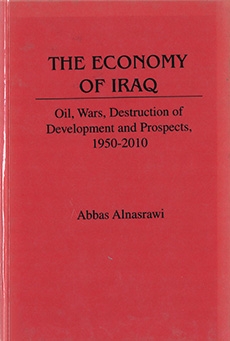|
INTRODUCTION
In 1960, Iraq’s real GDP measured in 1980 prices was $8.7 billion. In 1979 GDP peaked at $54 billion. And by 1993 Iraq’s GDP has declined to $10 billion, the equivalent of what it was in 1961. Put another way, these figures inform us that more than three decades of real GDP growth have been erased. But these dismal statistics tell a small part of this unique episode in the history of the second half of this century. This is so because the GDP in 1961 had to support 7 million people; in 1993 it had to support a population that has grown to nearly 21 million. Such a drastic collapse in per capita GDP translates into the nullification of nearly half a century of growth and improvement in the living standards of the population.
To place this change in some international context, Iraq in the years prior to its invasion of Kuwait was at the top of the per capita GDP ladder of developing countries. By 1993, real monthly earnings were lower than the monthly earnings of unskilled agricultural workers in India-one of the poorest countries in the world.
What happened to an economy noted for the wealth of its oil reserves, agricultural potential, water resources, relatively high rates of literacy and skills, vast access to foreign technology and expertise, an enviable balance-of-payments surplus and foreign reserves, and a long history of determined effort to develop and diversify the economy?
Simply stated, the central concern of this work is to find an explanation or explanations of what happened to cause this unprecedented and unparalleled collapse. To this end, the first chapter is devoted to an examination of the critical role of the oil sector in the Iraqi economy. Chapter 2 is devoted to a study of Iraq’s development policies under the monarchy and assesses development programs and policies in the 1950s. In the following chapter, the development plans of the republican regime in the period 1958-68 are evaluated. In Chapter 4, the Baath party’s economic philosophy, development strategies, and plans are analyzed. The demise of development that started with the outbreak of the Iran-Iraq war of 1980-88 is examined in Chapter 5. In Chapter 6, the economic consequences of the 1990 invasion of Kuwait, including the impact of the United Nations sanctions on the Iraqi economy, are examined. Chapter 7 examines Iraq’s changing economic fortunes in the period 1950-93, and the last chapter attempts to shed some light on Iraq’s economic future against the background of the economic destruction of the two Gulf wars.
The Economy of Iraq
Chapter 1
The Evolution of Iraq’s Oil Industry
One of the most striking features of the world oil map is the concentration of crude oil reserves in a few countries. In the Western Hemisphere, most of the oil reserves are concentrated in the United States, Venezuela, Mexico, and Canada. In the Eastern Hemisphere, they are concentrated in the former Soviet Union, North Africa, and the Middle East. Because of the stage of their economic development, the United States and the former Soviet Union developed their oil industries primarily to meet their countries’ own demands for energy. But since other oil-producing countries have a very low indigenous demand for energy, their oil resources were developed to meet world demand for oil-mainly that of the industrialized countries of Western Europe, Japan, and later on the United States.
Foreign capital and technology had to be called upon to develop oil resources since capital requirements for developing, producing, transporting, refining, and finally marketing oil products were well beyond the capabilities of countries like Venezuela, Iraq, Iran, Kuwait, Saudi Arabia, Libya, Indonesia, Nigeria, and Algeria.
The pattern of relationships between Iraq, as well as other oil-producing countries, and the oil companies exploiting oil resources was regulated by concession agreements. According to the provisions of the concession, the foreign-owned oil company obtained an exclusive right to develop and export Iraq’s oil; it was the sole determinant of the level of oil output and export; and it alone had the prerogative to set the price of oil. In short, the government had no input in the development or the pricing of what became the most important commodity of the national economy. The role of the government was a passive one in that it became a recipient of a fixed sum per unit of export.1
….. | 